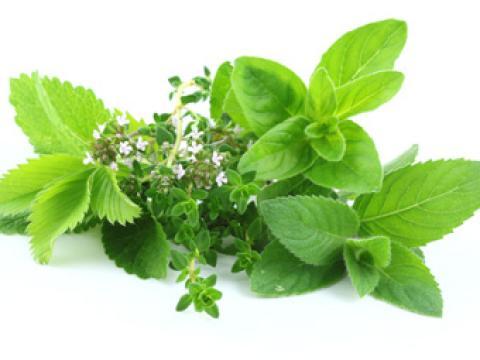Definition of the ENT system
The ENT system consists of the ear, nose and throat. Inhaled air passes through the nasal cavity or mouth. Air travels through the larynx on its way to the lungs, whereas food is diverted into the oesophagus. The part of the throat behind the mouth and nasal cavity is called the pharynx and conveys both food and air.
The mouth, nasal cavity and throat are connected to the middle ear by the Eustachian tube. They are also exposed to the outside environment and thus react to changes in temperature, humidity and pressure. They are also exposed to any viruses and bacteria which might be present in the surrounding environment; both in the air and on handled objects.

The body has natural protective features that restrict the access of pathogens to the ENT.
- Fine hairs in the nose protect the nasal cavity. They filter out dust and pollen so that these particles cannot enter the airways.
- The mucus present in this area also provides a very effective protective barrier which prevents pathogens and irritants reaching and damaging the mucous membranes.
- Fine hairs in the ears also filter out dust and other particles. Earwax (or cerumen) traps foreign substances and has antibacterial properties.
Infections of the ENT and digestive systems
Rhinoviruses are the main agents of ENT infection and can cause, depending on the location of the infection (upper or lower airways) cold, acute viral rhinitis, acute viral sinusitis, acute viral middle ear infection and viral pharyngitis1.
Each of these winter-season infections presents with identifiable symptoms. Simply visiting a healthcare professional is usually sufficient to obtain a precise diagnosis and a suitable treatment tailored to the individual patient. The text below provides details about the most common winter-season infections, their associated symptoms and information about some of the plants which have anti-infective properties.
Flu2
Flu (or influenza) symptoms appear 1 to 4 days after contamination and last for about 5 to 7 days. There are three types of influenza virus, called A, B and C. Types A and B are responsible for seasonal flu epidemics.
The illness is extremely contagious since the virus can survive outside the body for several hours or even days, particularly on clothes, handkerchiefs and even on inert surfaces. On a genetic level, flu viruses are changing continuously. This is the why it is possible to catch flu every year, since the virus is not recognised by the body’s immunological memory.
Most people who catch flu recover in one to two weeks without the need for medical treatment. More susceptible individuals (children, older adults, anyone with a chronic disease, pregnant women) must be monitored by a healthcare professional to avoid complications.
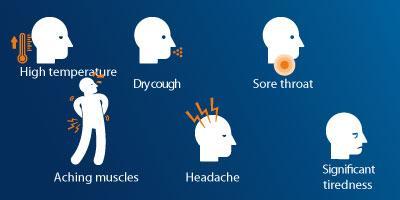
Cold3
This is the most common respiratory infection, both for children and adults. Cold accounts for 40% of winter-season respiratory illnesses, and in 95% of cases is caused by a virus.
Rhinoviruses are the main causative agents of a cold; an infection which is usually limited to the upper airways.
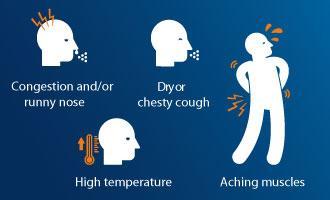
Sore throat3
Sore throat is an inflammation of the tonsils caused by a viral or bacterial infection. Bacterial sore throat can be treated with a course of antibiotics. On the contrary, they have no effect on viral sore throat and in fact encourage the development of bacterial resistance to antibiotics.
The virus or bacterium responsible for sore throat is an airborne infection, transmitted via material ejected by a cough or sneeze, by physical contact or by contact with objects which have themselves been contaminated by secretions from the nose or throat (toys, handkerchiefs, a telephone, etc.).

Bronchitis4
Acute bronchitis is an inflammation of the airways of the lungs (bronchi) which more commonly occurs in winter and particularly affects people whose lungs are susceptible to infection. It is usually caused by a virus, following a cold.
The individuals with a higher risk of contracting acute bronchitis are smokers, older adults and asthmatics. For most people, bronchitis lasts for 2 to 3 weeks.
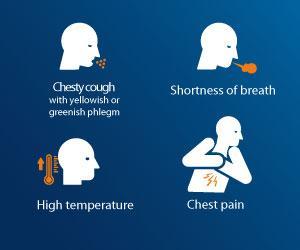
Gastroenteritis
Gastroenteritis is an inflammatory infection of the digestive system. On average it lasts for 2 to 3 days5, however, the individual may still be contagious up to 3 days after the symptoms have resolved. The most susceptible individuals, such as older adults or young children, should be monitored since there is a high risk of dehydration with this particular winter-season infection. One important precautionary measure to follow is to drink regularly until the symptoms resolve.
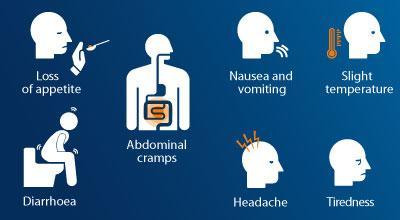
The main plants used to tread winter-season infections
Plants contain natural active ingredients which stimulate the immune system6. It is very interesting to note that the antiviral activity of some of these plants may be enhanced by combining them with probiotics.
Echinacea: Studies7 conducted to investigate echinacea have confirmed that the root has properties which stimulate immunity within the ENT and pulmonary system8.

The synergy between the active ingredients increases the production of the cells involved in immunity (B and T lymphocytes and macrophages)9; as a result, this is the main plant used to prevent recurring ENT-chest infections.
Cypress: Cypress nuts contain active ingredients with antiviral properties10. This plant is thus indicated in cases of acute or recurring viral infections. Its compounds have a direct action on the virus and thus can be used to eliminate the infection11.
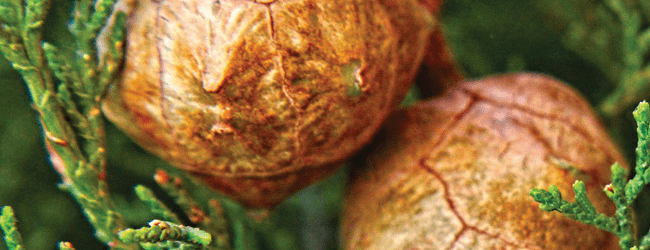
Medicinal sage: The diterpenes and rosmarinic acid contained in medicinal sage give it antioxidant and anti-inflammatory properties13.
Elder: Elderflower has anti-inflammatory properties14. This plant is particularly well suited to viral infections affecting children (ear infections, cold, etc.)

Thyme: The World Health Organisation recognises the use of thyme « Thyme extract has been used orally to treat dyspepsia and other gastrointestinal disturbances; coughs due to colds, bronchitis and pertussis; and laryngitis and tonsillitis (as a gargle) ».
Eucalyptus: Eucalyptus has antibacterial and expectorant properties and is a nasal and respiratory decongestant. The plant stimulates the mucous glands of the bronchial and digestive epithelium12.
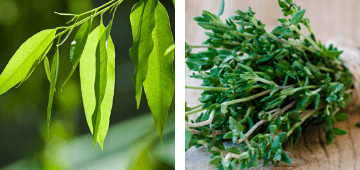
Peppermint14: The menthol in this plant gives it antiseptic properties and induces a feeling of freshness. Peppermint also has analgesic properties.
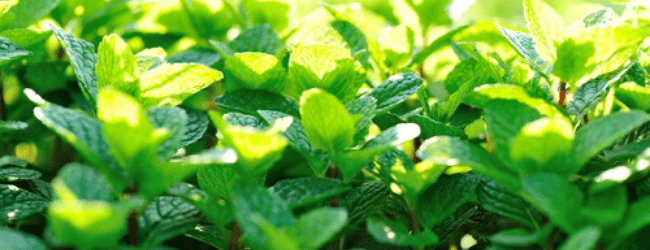
The European Scientific Cooperative on Phytotherapy (ESCOP) recommends using the essential oil distilled from this plant for digestive disorders and cough. Indeed, peppermint is used for indigestion, nausea and vomiting, pain in the stomach and gut, food poisoning, swallowed air and bloating.
Gumweed: Gumweed has expectorant, antispasmodic, cardiotonic and antiasthmatic properties. It is traditionally used to treat catarrh of the upper airways, cold, asthma, bronchitis, whooping cough and cystitis. It has antispasmodic, expectorant and cardiodepressant effects15.

Alone or in combination, as a natural extract or in the form of essential oils, these plants can support your health by preventing or managing winter-season pathologies. Ask a healthcare professional for advice on this subject. He or she will suggest the plant best suited to your individual condition and health status.




